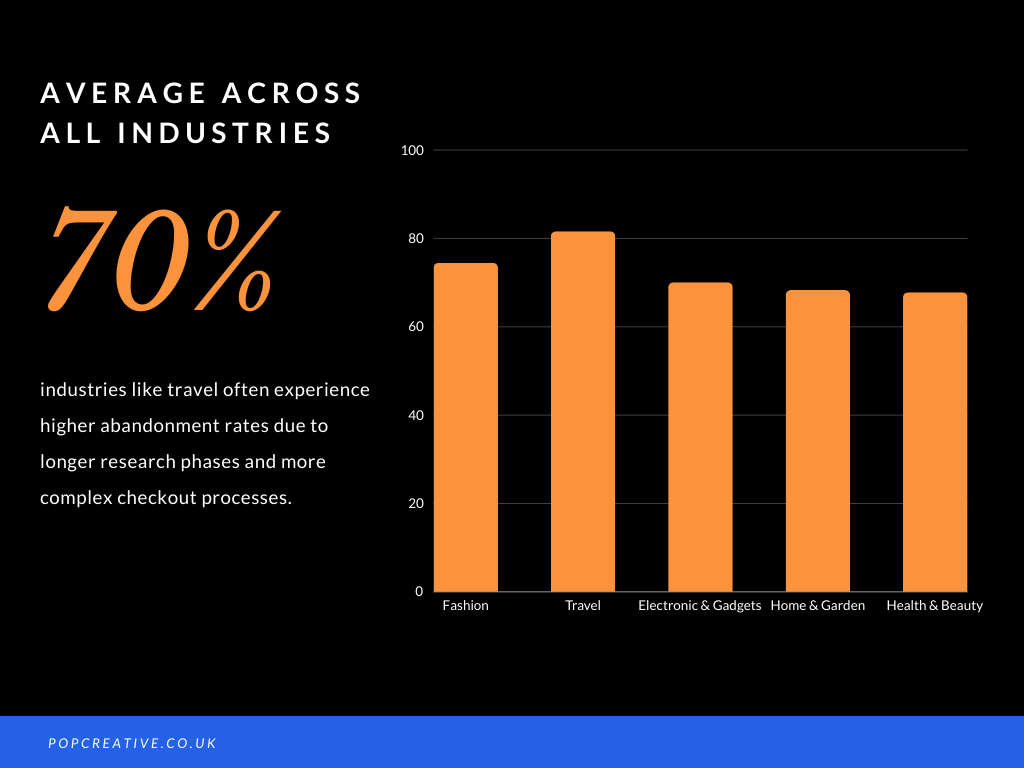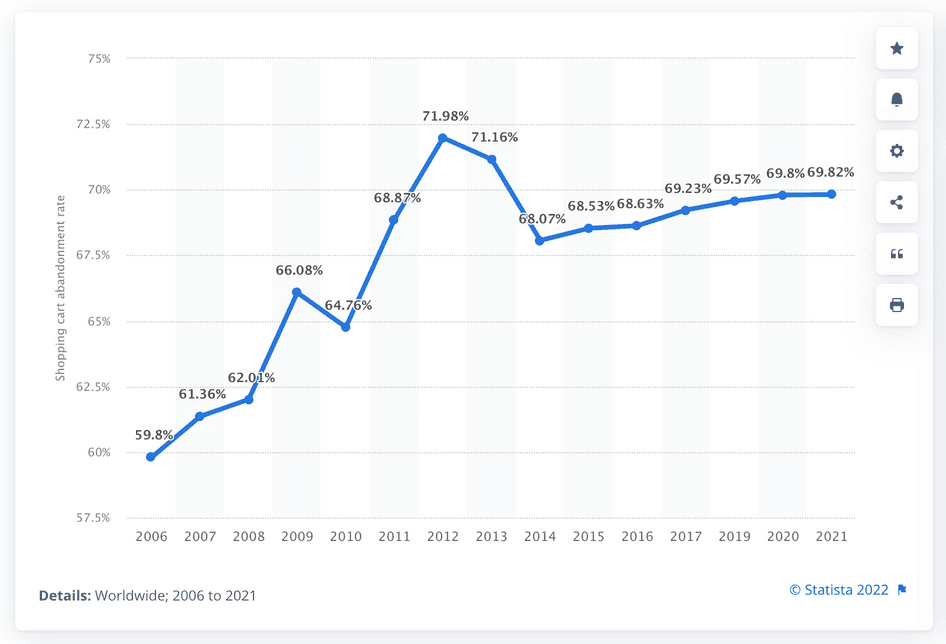
In the world of e-commerce, cart abandonment is an issue that poses a significant challenge for online retailers. As of 2024, according to Baymard, the average cart abandonment rate stands at a staggering 70%, reflecting a complex cooperation of factors that influence consumer behaviour and impact sales performance. This high rate not only signifies lost sales but also highlights opportunities for businesses to look at their UX and CRO to enhance their online shopping experiences.
In this post, we delve into:
- 15 reasons behind cart abandonment
- Abandoned cart trends across different industries
- How to solve abandon cart issues
A graph by Hotjar to show the increase in abandon cart rates from 2006 – 2021
15 Reasons why shoppers abandon carts?
1. Extra Costs Too High
Shoppers often experience shock when unexpected costs like taxes, fees, or high shipping charges suddenly inflate the total at checkout. These additional expenses can make the final price considerably higher than the anticipated cost, leading customers to reconsider their purchase decisions. Transparent pricing can mitigate this issue, encouraging customers to proceed with their purchase by avoiding last-minute surprises.
How to Solve: Retailers can reduce cart abandonment rate by clearly indicating all potential expenses upfront. Offering free or discounted shipping for certain order thresholds can also incentivise customers to complete their purchases.
2. Had to Create an Account
Requiring customers to create an account before completing a purchase can be a significant barrier, particularly for those seeking a quick and hassle-free transaction. This requirement often adds unnecessary steps to the checkout process and can deter those who prefer not to share personal information more than necessary. Offering a guest checkout option can reduce cart abandonment rates by catering to these customer preferences.
How to Solve: Allowing the user to use a guest checkout option will allow them to complete their purchases without the need to create an account, thereby streamlining the checkout process and reducing friction. According to PayPal, a 2022 study found that 72% of people with existing retail accounts still opted for guest checkout due to its convenience or speed.
3. Complex Checkout Processes
A lengthy or confusing checkout process can quickly frustrate customers, pushing them to abandon their carts. Each additional step in the checkout process increases the likelihood of abandonment, especially if customers feel overwhelmed by complex forms or excessive details. Streamlining the checkout process to include only essential information can help maintain customer engagement and increase conversion rates.
How to Solve: Retailers should optimise their checkout process by minimising the number of steps and simplifying form fields. Implementing a progress indicator can also help customers track their progress and feel more in control during checkout. ASOS, a popular fashion retailer, streamlines its checkout process by offering a one-page checkout, reducing the number of steps required to complete a purchase.
4. Can’t See the Total Cost
Transparency in pricing throughout the shopping experience is crucial for maintaining trust. When customers encounter hidden costs only at the final stage of checkout, it can lead to mistrust and dissatisfaction. Clearly displaying all costs upfront — including shipping, handling, and taxes — can prevent abandonment and foster a more trustworthy relationship between the retailer and the customer.
How to Solve: Providing a clear breakdown of all costs at every stage of the shopping journey helps build trust with customers. Offering shipping cost calculators or estimators can also give customers a clearer picture of their total expenses.
5. Don’t Trust the Site
Online security is a significant concern for many shoppers. A website that lacks secure sockets layer (SSL) certification, displays outdated design, or fails to provide clear security assurances might appear untrustworthy. Enhancing website security features and visibly displaying security badges can reassure customers, encouraging them to complete their purchases confidently.
How to Solve: Displaying trust signals such as SSL certificates, secure payment icons, and customer reviews can help install confidence in customers and alleviate concerns about the site’s trustworthiness.
6. Technical Problems
Glitches, errors, or website crashes during checkout disrupt the purchasing process and can prevent a sale from concluding successfully. Ensuring that the e-commerce platform is robust and regularly maintained is essential to minimise technical issues that could lead to cart abandonment. According to a study by Akamai, a one-second delay in website loading time can result in a 7% reduction in conversions.
How to Solve: Regularly testing the website for bugs and performance issues, as well as investing in reliable hosting and infrastructure, can help prevent technical problems during checkout.
7. Unfavourable Return Policies
A strict or unclear return policy can deter customers from completing a purchase, especially for high-value items or purchases where the customer is unsure about the product. Offering flexible and clearly communicated return policies can help reduce the perceived risk for customers and decrease cart abandonment.
How to Solve: Clearly communicating the return policy on product pages and during the checkout process helps set appropriate expectations for customers. Offering hassle-free returns and exchanges can also increase confidence in customers and reduce abandonment.
8. Lack of Payment Options
Customers expect a variety of payment options to choose from, including credit cards, digital wallets, and sometimes even local payment methods. Limited payment options can frustrate customers who then might abandon their carts if they cannot pay how they prefer. Expanding payment options to cover more methods can cater to a broader audience and reduce abandonment.
According to Shogun, implementing Apple Pay has helped merchants boost their conversion rates by up to 250% and improve checkout completion time by as much as 58%.
9. Card Declined
Issues such as card declines or errors in processing payments can abruptly halt the checkout process. Ensuring that the payment gateway is reliable and handling errors gracefully can help avoid these interruptions and keep the checkout process smooth.
How to Solve: Implementing features such as real-time card validation and providing helpful error messages can assist customers in resolving payment issues quickly, minimising the likelihood of abandonment.
10. “I’m Just Browsing”
Many customers use the shopping cart as a wish list or to bookmark items for later consideration. Recognising this behaviour, retailers can implement strategies such as email reminders or targeted ads to re-engage these customers and encourage them to revisit their carts.
How to Solve: Implementing features such as save for later or wishlist functionality allows customers to store items for future consideration without necessarily committing to a purchase immediately. Sending reminder emails or offering personalized discounts on saved items can prompt customers to revisit their carts and complete their purchases.
11. Shipping Costs and Delivery Options
High shipping costs or unappealing delivery options can be a significant deterrent. Offering various shipping methods, including faster delivery options for a premium or free shipping thresholds, can influence customers’ decisions to complete a purchase.
How to Solve: Offering free or discounted shipping for orders above a certain threshold can incentivise customers to add more items to their carts to qualify for the offer. Providing clear delivery timelines and options for expedited shipping can also help meet customers’ expectations and reduce abandonment.
12. Price Comparison
In an age where price comparison is easier than ever, customers may add items to their cart only to use them as a reference as they shop around. Offering price match guarantees or showing the value proposition of purchasing from your store can help retain these customers.
How to Solve: Highlighting unique selling points such as exclusive products, exceptional customer service, or loyalty programs can help differentiate your store from competitors and justify higher prices to customers. Offering price match guarantees can also instill confidence in customers and reassure them that they are getting the best deal.
13. Preference for In-Store Purchases
For certain products, especially those that customers prefer to see or try first, such as clothing or furniture, the preference for in-store shopping can lead to online cart abandonment. Enhancing online product descriptions, providing virtual try-on tools, or offering easy in-store returns might bridge this gap.
How to Solve: Providing detailed product descriptions, high-quality images, and customer reviews can help replicate the in-store shopping experience online and alleviate concerns about purchasing sight-unseen. Offering convenient in-store pickup or easy returns at physical locations can also appeal to customers who prefer the immediacy and tangibility of in-store shopping. IKEA offers virtual room planning tools on its website to help customers visualise products in their own homes before making a purchase.
14. Technical Issues Beyond Checkout
Continuous technical issues, such as slow site performance or navigation difficulties, can degrade the user experience and lead to cart abandonment. Regular testing and updates can help ensure the site performs well and keeps users engaged throughout their shopping journey.
How to Solve: Regularly monitoring website performance and user feedback, as well as conducting regular audits and updates to address technical issues, can help maintain a smooth and seamless shopping experience for customers. Investing in reliable hosting and infrastructure can also help prevent technical problems from occurring.
15. Discount Code Doesn’t Work
Many online shoppers are motivated by the opportunity to save money through discounts or promotional offers. However, if a discount code provided by the customer is not functioning properly or is deemed invalid at the checkout stage, it can lead to frustration and ultimately result in cart abandonment.
How to Solve: Retailers can minimize cart abandonment due to non-functional discount codes by regularly testing and verifying codes to ensure they are valid and applicable. Providing clear instructions for applying discount codes and offering alternative incentives, such as free shipping or bonus gifts, can also help retain customers who encounter issues with discount codes.
Cart abandonment rates by industry
Cart abandonment rates vary widely across different industries, influenced by factors such as product type, consumer expectations, and the complexity of the buying process. For example, industries like travel often experience higher abandonment rates due to longer research phases and more complex checkout processes. In contrast, sectors with simpler and quicker checkouts, such as fashion, might see slightly lower rates.

Let’s take a look at some industries in more detail:
1. Fashion
- Abandonment Rate: 74.5%
- Main Issues: High shipping costs, complex checkout processes, browsing with no intent to buy immediately, and price comparisons.
2. Travel
- Abandonment Rate: 81.6%
- Main Issues: Hidden fees, complex booking processes, checking competitor prices, and lack of trust.
3. Electronics & Gadgets
- Abandonment Rate: 70.1%
- Main Issues: Price sensitivity leading to extensive price comparisons and high extra costs.
4. Home & Garden
- Abandonment Rate: 68.3%
- Main Issues: Considered purchases result in lower impulse buying and abandonment.
5. Health and Beauty
- Abandonment Rate: 67.8%
- Main Issues: Extra costs and the requirement to create an account before purchasing.
It’s important to look at the UX and CRO of your website to combat cart abandonment, implement the solutions and we can guarantee you will see an increase in conversions. Tackling cart abandonment head-on through strategic improvements and a deeper understanding of consumer behaviour, knowing how people use your site and how they navigate through it is important for further improvements. Making it easy for a user to check-out will overall improve customer satisfaction.
 Shopify Development
Shopify Development  Social Media & Blogs
Social Media & Blogs  PPC
PPC 

